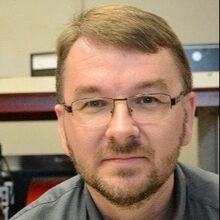
Dr. Mewes is a founding member of the CCBM. In 2010 Prof. Mewes received a National Science Foundation CAREER award for the investigation of the magnetization dynamics and damping in magnetic nanostructures. In 2011 he became a Visiting Fellow of the Center for Nanoscale Science and Technology at the National Institute for Standards and Technology in Gaithersburg, in 2014 he received the IBM Faculty Award, and in 2020 he was named Distinguished Lecturer of the IEEE Magnetics Society. His research has been funded by NSF, NASA, DARPA, and several industry partners. (http://magneticslab.ua.edu/).
Representative Publications
- Structural and magnetic properties of NiFe2O4 thin films grown on isostructural lattice-matched substrates. S. Regmi, Z. Li, A. Srivastava, R. Mahat, S. KC, A. Rastogi, Z. Galazka, R. Datta, T. Mewes, and A. Gupta. Appl. Phys. Lett. 118:152402, 2021.
- Synthesis and characterization of iron oxide superparticles with various polymers. S. Mansur, A. Rai, R.A. Holler, T. Mewes, Y. Bao. Journal of Magnetism and Magnetic Materials. 515:167265, 2020.
- Higher-order perpendicular magnetic anisotropy and interfacial damping of Co/Ni multilayers. A. Rai, A. Sapkota, A. Pokhrel, M. Li, M. De Graef, C. Mewes, V. Sokalski, and T. Mewes. Phys. Rev. B 102:174421, 2020.
- Formation of zero-field skyrmion arrays in asymmetric superlattices. M. Li, A. Rai, A. Pokhrel, A. Sapkota, C. Mewes, T. Mewes, M. De Graef, and V. Sokalski. Appl. Phys. Lett. 117: 112403, 2020.
- Conductivitylike Gilbert Damping due to Intraband Scattering in Epitaxial Iron. B. Khodadadi, A Rai, A. Sapkota, A. Srivastava, B. Nepal, Y. Lim, D.A. Smith, C. Mewes, S. Budhathoki, A.J. Hauser, M. Gao, J.-F. Li, D.D. Viehland, Z. Jiang, J.J. Heremans, P.V. Balachandran, T. Mewes, and S. Emori. Phys. Rev. Lett. 124:157201, 2020
Research Interests
Research in Prof. Mewes’ Magnetics Laboratory focusses on epitaxial growth of magnetic thin films, characterization of magnetic nanoparticles, exchange bias, influence of ion irradiation on magnetic properties, magnetic resonance force microscopy, broadband ferromagnetic resonance, magnetization dynamics, damping, and micromagnetics. This also includes topologically protected domain wall skyrmions, brain inspired novel spintronic computing platforms, and neuromorphic computing.

